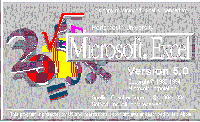Volume 12, Issue 2, 1998

Quantitative Business Methods Using Excel
- David Whigham
Oxford University Press, June 1998.
Paperback, ISBN 0-19-877545-8. UK Price:£22.99
476 pages, numerous figures and Excel screen-dumps, with accompanying Workbook diskette.
David Whigham has produced the book that I kept meaning to write, that is an up to date textbook for economics and business students introducing them to spreadsheets and their application to relevant quantitative problems. Just as back in 1990 when I published my book on Quantitative Analysis for Economics and Business I had to decide whether to gear the book to one particular spreadsheet package (I chose Lotus 1-2-3) and hope that users of other packages would be able to see how to adapt the instructions to work with other programs, David has taken the understandable step of assuming that students either have access to Excel (version 5.0), or can see how to adapt the instructions given to other similar packages.
There are twelve chapters covering the following topics:
- 1 Introduction to Excel,
- 2 Principles of elementary modelling,
- 3 Business modelling using more advanced functions,
- 4 Equation solving and optimisation using the Excel Solver,
- 5 Financial mathematics,
- 6 Discounting techniques,
- 7 Matrix algebra,
- 8 Introductory Statistical Analysis,
- 9 Further descriptive statistical methods,
- 10 Simple Linear Regression,
- 11 Inferential statistics,
- 12 Multiple Regression
The book covers pretty well all the topics I would want to see. I would perhaps have included a chapter on difference equation modelling but otherwise there is a very nice balance between mathematical and statistical methods. All the chapters provide plenty of examples of the use of the quantitative methods in their application to economic and business problems. For example the chapter on matrix algebra has an application to input-output models and the chapter on equation solving and optimisation covers both linear programming and more complicated non-linear optimization problems subject to constraints.
There is a nice chapter early on in the book which sets out some of the principles of spreadsheet modelling (although in view of points raised by Jocelyn Paine in his paper at the CALECO 98 conference - see the report elsewhere in CHEER - perhaps more should have been said about testing and checking spreadsheet models for errors).
Many of the files relating to the problems described in the book are printed in full - some are just too big - but all are available on the accompanying disk. Each chapter ends with a set of exercises (solutions provided) and there is plenty of evidence that the material has been thoroughly class-tested. In reviewing this book I only had a chance to work through a small sample of the problems given, but I found no errors either in the expression of the questions posed or the answers supplied.
This text has been written so as to provide both an explanation of the overall nature of what is to be achieved (that is a full discussion of the economics and business problems and the methods that can be used to solve them) and also clear instructions on how it is to be done (that is step by step hands-on directions as to how to set up the spreadsheet, shown clearly in bold). Ideally I should have liked to have seen a little more real (as opposed to fictitious) data being used in the problems, and also something about linking spreadsheet files to other packages. However this is a minor criticism and I am sure that this book will prove both useful to lecturers teaching quantitative courses and popular with students taking such courses.
Guy Judge
University of Portsmouth

